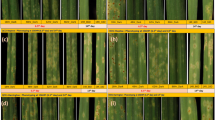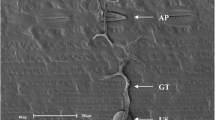Abstract
The infection process of most rust fungi start with spore germination, directional growth of the germ tube towards a stoma, differentiation of an appressorium over the stoma, and penetration into the substomatal cavity. In the South American wild barley Hordeum chilense Roem. & Schult., wide variation occurs in the degree to which several rust fungal species are able to form appressoria over the stomata. Apparently, features of the plant may hamper early stages of the infection process. Such an early defence is called avoidance. In order to find out how germ tube growth is directed towards stomata, and whether the cuticular wax layer plays a role in this orientated growth and in appressorium differentiation, several orientation and differentiation parameters of Puccinia hordei germ tubes were measured on H. chilense leaves with and without the wax layer. Orientated growth of the germ tubes started upon contact with the epidermal cell junctions. The growth of lateral branches of the germ tube over the first epidermal cell junction that it meets, may help the germ tube to grow along the transverse axis of the leaf. No evidence was found of attraction of the germ tube to stomata. Removal of the cuticular wax layer did not result in loss of germ tube orientation. This suggests that the leaf wax layer has no role in the guidance of germ tubes. On high avoidance accessions, removal of the wax layer allowed appressoria to develop over stomata that would otherwise be overgrown. No effect of the cell widths in stomatal complexes was found on the chance that stomata were overgrown. This suggests that the overgrowth of stomata on H. chilense leaves by P. hordei germ tubes is mainly caused by the wax covering of the stomatal apparatus.
Similar content being viewed by others
References
Allen EA, Hazen BE, Hoch HC, Kwon Y, Leinhos GME, Staples RC, Stumpf MA and Terhune BT (1991a) Appressorium formation in response to topographical signals by 27 rust species. Phytopathology 81: 323–331
Allen EA, Hoch HC, Stavely JR and Steadman JR (1991b) Uniformity among races of Uromyces appendiculatus in response to topographic signalling for appressorium formation. Phytopathology 81: 883–887
Collins TJ and Read ND (1997) Appressorium induction by topographical signals in six cereal rusts. Physiological and Molecular Plant Pathology 51: 169–179
Edwards MC and Bowling DJF (1986) The growth of rust germ tubes towards stomata in relation topHgradients. Physiological and Molecular Plant Pathology 29: 185–196
Hoch HC, Staples RC (1987) Structural and chemical changes among the rust fungi during appressorium development. Annual Reviews of Phytopathology 25: 231–247
Hoch HC, Staples RC, Whitehead B, Comeau J and Wolf ED (1987) Signaling for growth orientation and cell differentiation by surface topography in Uromyces. Science 235: 1659–1662
Jenks MA and Ashworth EN (1999) Plant epicuticular waxes: Function, production, and genetics. Horticultural Reviews 23: 1–69
Lewis BG and Day JR (1972) Behaviour of uredospore germtubes of Puccinia graminis tritici in relation to the fine structure of wheat leaf surfaces. Transactions of the British Mycological Society 58: 139–145
Littlefield LJ and Heath MC (1979) Ultrastructure of Rust Fungi. Academic Press, New York
Niks RE (1990) Effect of germ tube length on the fate of sporelings of Puccinia hordei in susceptible and resistant barley. Phytopathology 80: 57–60
Parlevliet JE (1976) Evaluation of the concepts of horizontal resistance in the barley/Puccinia hordei host-pathogen relationship. Phytopathology 66: 847–851
Read ND, Kellock LJ, Collins TJ and Gundlach AM (1997) Role of topography for infection-structure differentiation in cereal rust fungi. Planta 202: 163–170
Rubiales D and Niks RE (1992) Low appressorium formation by rust fungi on Hordeum chilense lines. Phytopathology 10: 1007–1012
Rubiales D and Niks RE (1996) Avoidance of rust infection by some genotypes of Hordeum chilense due to their relative inability to induce the formation of appressoria. Physiological and Molecular Plant Pathology 49: 89–101
Staples RC, Grambow HJ, Hoch HC and Wynn W (1983) Contact with membrane grooves induces wheat stem rust uredospore germlings to differentiate appressoria but not vesicles. Phytopathology 73: 1436–1439
Vaz Patto MC and Niks RE (2000) Orientation of germ tubes of Puccinia hordei on the Hordeum chilense leaf surface. In: Barna B and Király Z (eds) Proceedings of the 10th Cereal Rusts and Powdery Mildews Conference. Budapest, Hungary, August 28—September 1, 2000 (pp 213–220) Akadémiai Kiadó, Budapest, Hungary
Vaz Patto MC, Aardse A, Buntjer J, Rubiales D, Martín A and Niks RE (2001) Morphology and AFLP markers suggest three Hordeum chilense ecotypes that differ in avoidance to rust fungi. Canadian Journal of Botany 79: 204–213
Wynn W (1976) Appressorium formation over stomatas by the bean rust fungus: Response to a surface contact stimulus. Phytopathology 66: 136–146
Author information
Authors and Affiliations
Corresponding author
Rights and permissions
About this article
Cite this article
Vaz Patto, M., Niks, R. Leaf wax layer may prevent appressorium differentiation but does not influence orientation of the leaf rust fungus Puccinia hordei on Hordeum chilense leaves. European Journal of Plant Pathology 107, 795–803 (2001). https://doi.org/10.1023/A:1012410330287
Issue Date:
DOI: https://doi.org/10.1023/A:1012410330287




